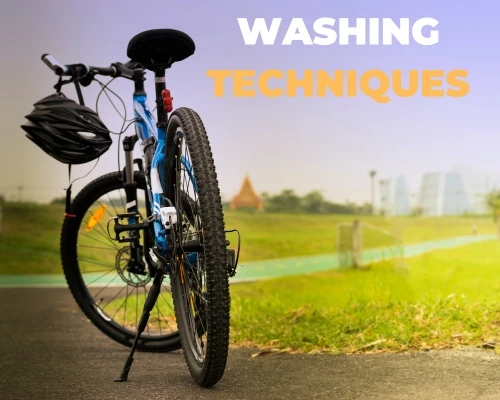Ever noticed that distinct ‘cyclist’ aroma after a ride? It clings to gear, demanding attention. Washing cycling gear seems straightforward.
Yet, it’s a chore many dread. Why? Fear of ruining those pricey fabrics. Or perhaps it’s the confusing care labels. Maybe it’s the worry that the gear won’t feel the same.
Your cycling gear is your second skin on the road. It faces sweat, dirt, and sometimes, the harsh elements. It deserves care, but how?
This concern isn’t trivial. Improper care shortens gear life, wastes money, and affects comfort and performance. We understand. We’ve been there, staring at a pile of gear, puzzled.
Let’s tackle this together. Learn to clean your gear right. Keep it looking good, smelling fresh, and performing at its best. Ready to transform your gear care routine? Let’s dive in.
How to Wash Your Cycling Gear
Prepare Your Cycling Gear
Zip and Flip
Start by zipping up shorts and jerseys. Turn them inside out to protect prints and colors.
Bag the Velcro
Items with hook-and-loop closures? Into a mesh bag they go. Fasten them up to avoid snags.
Stand Alone
Cycling apparel demands a solo journey through the wash. It’s not just a preference; it’s a must.
Separate from the Pack
Solo Wash
Keep your cycling kit away from other laundry. This isn’t about elitism; it’s about care.
Dye Defense
A dye-trapping sheet in the wash saves your gear from unwanted color parties.
Cool and Gentle
Cold Only
Warm water is a fabric’s foe. Cold water maintains material integrity, preserving your gear’s life.
Gentle Suds
Harsh chemicals? Hard pass. Opt for mild detergents and specific odor busters. They’re like a spa treatment for your gear.
Air is the Answer
Line Dry
The dryer is not a friend to your kit. Air drying keeps fibers fit and logos intact.
Heat is a Hazard
Avoid the temptation of a quick dry. High heat damages, decays, and disappoints.
Post-Ride Rituals
Prompt Washing
Don’t let your kit linger in its own adventure tales. Wash promptly to keep fabrics fresh.
Pore Patrol
Synthetic fabrics breathe through microscopic pores. The wrong soap can clog these, stifling your gear.
Spot On
Stain Strategy
Pre-treat the memories of the road. Mud and grass stains require a bit more than just hope to remove.
Sorting and Separating

Understanding Fabric Types and Their Care
High-Performance Technical Fabrics
Cycling gear boasts fabrics designed for the rigors of the road. They wick moisture, keeping you dry. But, these marvels of textile technology are sensitive. The wrong wash cycle or detergent spells disaster.
Careful Cleaning
A mild detergent whispers sweet nothings to your gear. It cleans without harshness. For odors that linger like unwelcome guests, OxiClean steps in, removing smells without harming fabric integrity.
Drying Matters
The dryer is the arch-nemesis of cycling apparel. It’s not just about shrinkage. Heat breaks down fibers, bids adieu to adhesives, and fades glory. Line dry instead. Even socks yearn for the gentle kiss of outdoor air.
The Role of Color Separation in Laundry Care
First Wash Wisdom
First impressions matter, especially in laundry. New cycling apparel can shed dye like autumn leaves. Wash these items solo or with a color-catcher sheet. It traps dye, preventing a wardrobe of unintended pastels.
Cold Wash, Safe Colors
Cold water is a mediator. It prevents the clash of colors, keeping darks dark and lights bright. It’s a simple step with profound impact on maintaining the vibrancy and integrity of your gear.
Washing Techniques

The Best Detergents for Athletic Apparel
Choosing Wisely
The detergent aisle is a jungle. Here’s a compass:
Gain Original + Aroma Boost: Floral scents linger long after the wash. Gentle on fabrics, kind on wallets. Yet, seekers of unscented paths, beware.
Tide Plus Febreze Fresh Sport: Lauded by experts, these pods tackle odors and stains head-on. They’re the MVPs in the fight against workout wear woes.
HEX Performance: Tough on stinks and stains, gentle on the planet. Available unscented or scented, it plays nice with eco-conscious routines.
Rockin’ Green Platinum Series: Powder power for the eco-friendly athlete. It’s as kind to the earth as it is to your activewear.
All Sport Activewear Detergent: Nature’s answer to synthetic smells and stains. Safe for the family, harsh on odor.
Hand Washing vs. Machine Washing: Pros and Cons
Hand Washing: The Delicate Dance
Pros: It’s like a spa day for your gear. Delicates and pricey pieces get the TLC they deserve. Longevity is the reward for your effort.
Cons: Time and elbow grease required. Not for the faint of heart or those short on time.
Machine Washing: The Efficient Engine
Pros: Quick, effortless, and efficient for the everyday. It handles the bulk of your laundry with ease.
Cons: The rough and tumble can be too much for some. Delicates may emerge defeated, with shrinkage or damage as battle scars.
Special Care for Specific Gear

Helmets and Shoes: A Cleaning Guide
Helmets: Your Head’s Best Friend
Pads and Liners: Remove and wash them as per the guide. They’re the frontline against sweat.
Shell Care: A gentle touch with mild detergent keeps the exterior pristine. Harsh chemicals? Not here.
Rinse and Dry: Let water do the final sweep. Air dry away from heat to preserve integrity.
Safety Check: Inspect for damage. Safety compromised? Time for a new helmet.
Shoes: The Foundation of Every Ride
Insoles: Out they come for a separate cleanse. Follow care instructions closely.
Exterior Cleaning: Mild detergent and diligence work wonders. Keep the inside dry – water is the enemy within.
Brush Off the Adventures: A soft brush will do. It’s about removing dirt, not memories.
Air Dry: Natural air is the best remedy. Heat is the villain in this story.
Wear Check: Damage or wear? It might be time for a new journey with a new pair.
Taking Care of Waterproof and Windproof Items
Guardians of Comfort
Wash Wisely: Mild detergent and cold water. Fabric softeners and bleach? They’re on the blacklist.
Machine or Hand Wash: Treat them gently. Front-loaders or hands are allies in care.
Drying: Avoid wringing. Low heat or air dry to protect the waterproof shield.
Routine Check: Regular inspections ensure longevity. Signs of wear mean it’s repair or replace time.
Gear Maintenance Beyond Washing
Regular Maintenance Tips for a Long-Lasting Kit
Inspection is Key
Wear and Tear: Regularly check for loose threads, worn padding, and other signs of aging. Early detection, early solution.
Preventative Measures: Don’t wait for a breakdown. Regular maintenance is the shield against unexpected failures.
Pre-Transport Checks: Inspect before moving. Avoid downtime in places where replacements are tales of fiction.
Following the Script
OEM Guidance: The maker’s manual isn’t just for show. It’s the roadmap for maintenance, cleaning, and part replacement.
Efficiency and Value: Proper care reduces downtime, boosts performance, and can even uplift resale value. Maintenance isn’t a cost; it’s an investment.
The Importance of Repairing and Recycling Gear
Sustainability Through Repair
Extend and Conserve: Before tossing, think repair. It’s about giving gear a second chance, saving resources, and curtailing waste.
Prevention Over Cure: Timely repairs can fend off premature replacements. It’s eco-friendly and wallet-friendly.
Recycle and Renew
End of the Road: When gear’s journey ends, recycling starts. It’s a commitment to minimizing waste and embracing sustainability.
Repair Considerations
DIY or Professional: Some fixes are home-bound; others need expert hands. Knowing the difference saves time and ensures quality.
Cost vs. Longevity: Weigh the repair costs against the gear’s extended life and performance. It’s a balancing act for informed decision-making.
As an Amazon Associate, I earn from qualifying purchases, at no additional cost to you. Read Our Affiliate Disclosure.

